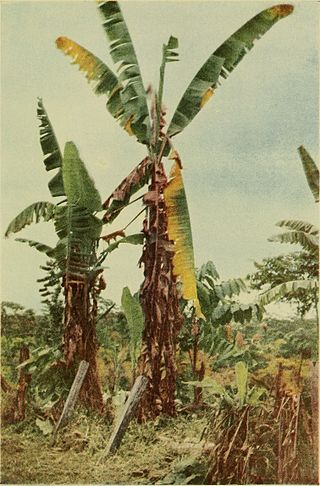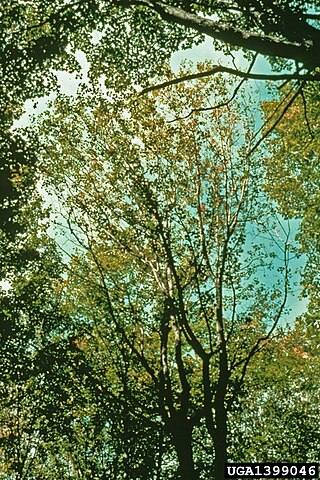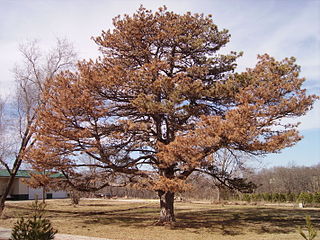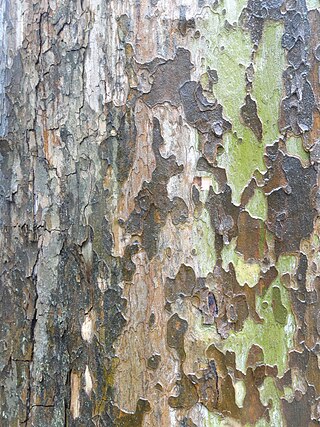
Panama disease is a plant disease that infects banana plants. It is a wilting disease caused by the fungus Fusarium oxysporum f. sp. cubense (Foc). The pathogen is resistant to fungicides and its control is limited to phytosanitary measures.

Oak wilt is a fungal disease caused by the organism Bretziella fagacearum that threatens Quercus spp. The disease is limited to the eastern half of the United States; first described in the 1940s in the Upper Mississippi River Valley. The pathogen penetrates xylem tissue, preventing water transport and causing disease symptoms. Symptoms generally consist of leaf discoloration, wilt, defoliation, and death. The disease is dispersed by insect vectors and to adjacent trees through underground root networks. However, human spread is the most consequential dispersal method. Moving firewood long distances can potentially transport diseases and invasive species.

Phomopsis cane and leaf spot occurs wherever grapes are grown. Phomopsis cane and leaf spot is more severe in grape-growing regions characterized by a humid temperate climate through the growing season. Crop losses up to 30% have been reported to be caused by Phomopsis cane and leaf spot.

Ceratocystis fimbriata is a fungus and a plant pathogen, attacking such diverse plants as the sweet potato and the tapping panels of the Para rubber tree. It is a diverse species that attacks a wide variety of annual and perennial plants. There are several host-specialized strains, some of which, such as Ceratocystis platani that attacks plane trees, are now described as distinct species.
Erythricium salmonicolor is a species of fungus in the family Corticiaceae. Basidiocarps are effused, corticioid, smooth, and pinkish and grow on wood. The fungus is a commercially significant plant pathogen which has become a serious problem, especially in Brazil. Erythricium salmonicolor causes Pink Disease, most commonly in Citrus, although E. salmonicolor has a wide host range including rubber and cacao trees. Pink Disease causes branch and stem die-back due to canker formation. The cankers are recognizable by gum exudation and longitudinal splitting of the bark.

Macrophomina phaseolina is a Botryosphaeriaceae plant pathogen fungus that causes damping off, seedling blight, collar rot, stem rot, charcoal rot, basal stem rot, and root rot on many plant species.
Ceratocystis paradoxa or Black Rot of Pineapple is a plant pathogen that is a fungus, part of the phylum Ascomycota. It is characterized as the teleomorph or sexual reproduction stage of infection. This stage contains ascocarps, or sacs/fruiting bodies, which contain the sexually produced inoculating ascospores. These are the structures which are used primarily to survive long periods of time or overwinter to prepare for the next growing season of its host. Unfortunately, the sexual stage is not often seen in the natural field but instead the anamorph, or asexual stage is more commonly seen. This asexual stage name is Thielaviopsis paradoxa and is the common cause of Black rot or stem-end rot of its hosts.

Moniliophthora perniciosa is a fungus that causes "witches' broom disease" (WBD) of the cocoa tree T. cacao. This pathogen is currently limited to South America, Panama and the Caribbean, and is perhaps one of the best-known cocoa diseases, thought to have co-evolved with cocoa in its centre of origin.

Moniliophthora roreri is a basidiomycete fungus that causes frosty pod rot disease, one of the most serious problems for cacao production in Latin America. This disease and together with witches’ broom disease and black pod rot constitute the cacao disease trilogy. It causes serious losses in southwestern parts of South America; spores are dry and powdery and are spread easily by water movement, wind, or movement of pods; disease spread is highest during periods of high rainfall.

Ceratocystis coerulescens is an ascomycete fungus and the causal agent of sapstreak disease in sugar maple trees. There is debate about whether it is one species or two; the second being Ceratocystis virescens. For simplicity, this page will refer to this pathogen as one species. It is also known by its anamorph name Endoconidiophora virescens.
Mal secco is a disease caused by the conidia-producing fungal plant pathogen Phoma tracheiphila. It mainly causes disease to citrus trees in the Mediterranean. In particular it causes damage to lemon trees in the Mediterranean basin. The plant pathogen, Phoma tracheiphila, is rain- and wind-disseminated.

The Microascales are an order of fungi in the class Sordariomycetes, subclass Hypocreomycetidae. This is a relatively small order of mostly saprobic fungi that live in soil, rotting vegetation and dung. Some species are plant pathogens, such as Ceratocystis fimbriata, transmitted by beetles to living trees and causing cacao wilt and many other economically important diseases. Species in the genus Pseudallescheria are pathogenic to humans The order was circumscribed in 1980. Wijayawardene et al. in 2020 added more families and genera to the order.

A wilt disease is any number of diseases that affect the vascular system of plants. Attacks by fungi, bacteria, and nematodes can cause rapid killing of plants, large tree branches or even entire trees.

Fusarium circinatum is a fungal plant pathogen that causes the serious disease pitch canker on pine trees and Douglas firs. The most common hosts of the pathogen include slash pine, loblolly pine, Monterey pine, Mexican weeping pine, and Douglas fir. Like other Fusarium species in the phylum Ascomycota, it is the asexual reproductive state of the fungus and has a teleomorph, Gibberella circinata.
In molecular biology, the cerato-platanin family of proteins includes the phytotoxin cerato-platanin (CP) produced by the Ascomycete Ceratocystis platani. CP homologs are also found in both the Ascomycota and the Basidiomycota branches of Dikarya. This toxin causes the severe plant disease: canker stain. This protein occurs in the cell wall of the fungus and is involved in the host-pathogen interaction and induces both cell necrosis and phytoalexin synthesis which is one of the first plant defense-related events. CP, like other fungal surface proteins, is able to self-assemble in vitro. CP is a 120 amino acid protein, containing 40% hydrophobic residues. It is one of the rare examples of protein in which contains a Hopf link. The link is formed by covalent loops - the pieces of protein backbone closed by two disulphide bonds. The N-terminal region of CP is very similar to cerato-ulmin, a phytotoxic protein produced by the Ophiostoma species belonging to the hydrophobin family, which also self-assembles.
Bot canker of oak is a disease on stems, branches and twigs of oak trees in Europe and North America. The casual agent of Bot canker of oak is the fungus Botryosphaeria corticola. Bot canker of oak causes lesions and cankers on a wide range of oaks in Europe and most recently live oaks in North America. Some infections were formerly attributed to Botryosphaeria stevensii, but most likely represent infections by Botryosphaeria corticola. Botryosphaeria corticola is distinguishable from Botryosphaeria stevensii via ITS rDNA sequencing.

Ceratocystis platani is a fungus that causes a disease on plane trees in the genus Platanus, mostly in North America and Southern Europe.
Coffee wilt disease (tracheomycosis) is a common wilt that results in complete death of coffee trees it infects. This vascular disease is induced by the fungal pathogen known by its teleomorph Gibberella xylarioides. In 1927, coffee wilt disease (CWD) was first observed in the Central African Republic where it developed slowly and went on to cause two epidemics between the 1930s and the 1960s. Coffee wilt disease was first seen in Coffea excelsa.

Rapid ʻŌhiʻa Death (ROD) is a fungal disease that is rapidly killing forests of ʻōhiʻa —an ecologically important native tree species within the Hawaiian Islands that has provided a plethora of habitats for endangered birds and other species. Initially reported by landowners in Puna in 2010, ROD spread quickly across tens of thousands of acres of ʻŌhiʻa trees on the Hawaiian Islands. To date, hundreds of thousands of these trees have died from this fungal disease alone. Previously healthy Ōhiʻa trees have been observed to die within a few days to weeks, which is why the disease is known as "Rapid Ōhiʻa Death".

Cryphalus mangiferae, the mango bark beetle, is a tiny tropical bark beetle which attacks mango trees. It is often cited as a vector of plant pathogenic fungi infecting mango trees. The species belongs to the family Curculionidae, subfamily Scolytinae.













